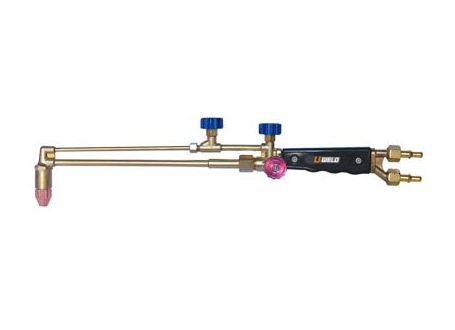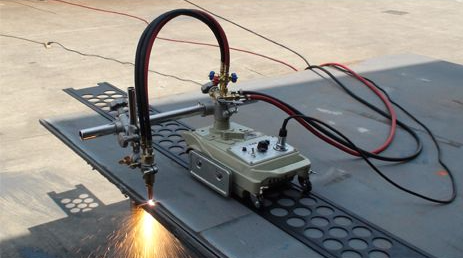Gas cutting, also known as oxy-fuel cutting or oxy-acetylene cutting, is a process used to cut ferrous metals using a combination of fuel gases and oxygen. This method is widely used in metal fabrication, construction, and various industrial applications due to its effectiveness in cutting thick steel plates and other materials. Here’s a detailed explanation of how a gas cutting machine works:
Components of a Gas Cutting Machine
Cutting Torch: The primary tool used to direct the flame and oxygen jet to the cutting area.
Fuel Gas Supply: Common fuel gases include acetylene, propane, and natural gas.
Oxygen Supply: A high-pressure oxygen source is required to support combustion and cutting.
Regulators: Devices that control the pressure of the fuel gas and oxygen supplied to the torch.
Hoses: Flexible tubes that deliver fuel gas and oxygen from the supply tanks to the cutting torch.
Cutting Nozzle: A specialized nozzle on the torch that shapes and directs the gas flow.

Cutting Torch
The Cutting Process
Preparation:
Ensure the workpiece is clean and free from contaminants that could affect the cutting process.
Set up the cutting torch with appropriate nozzles and adjust the regulators to provide the correct gas pressures.
Ignition:
Open the fuel gas valve slightly and ignite the gas using a striker or lighter.
Adjust the fuel gas flow to obtain a small, stable flame.
Gradually open the oxygen valve and adjust both gas flows to produce a neutral flame (a flame with a well-defined inner cone and no excessive soot).
Preheating:
Position the cutting torch over the starting point of the cut.
Use the preheating flame (neutral flame) to heat the metal to its ignition temperature (typically around 700-900°C or 1292-1652°F for steel).
Cutting:
Once the metal reaches the ignition temperature, open the cutting oxygen valve to release a high-pressure stream of oxygen.
The oxygen jet reacts with the heated metal, causing rapid oxidation (combustion) and generating heat.
The intense heat melts the metal and the oxygen stream blows away the molten metal and slag, creating a cut.
Move the torch along the desired cutting path, maintaining a consistent speed and distance to ensure a clean, continuous cut.

Gas Cutting Machine
Key Principles of Gas Cutting
Exothermic Reaction:
The cutting process relies on the exothermic reaction between the oxygen and the base metal. This reaction releases a significant amount of heat, sustaining the cutting process.
Preheating and Cutting Oxygen:
The preheating flame brings the metal to its ignition temperature but does not melt it.
The cutting oxygen jet provides the necessary oxygen to sustain the oxidation reaction, cutting through the metal.
Oxidation:
Only metals that form oxides with lower melting points than the base metal can be cut effectively using gas cutting. This is why ferrous metals like steel are suitable for gas cutting, while non-ferrous metals like aluminum and stainless steel are not, as their oxides have higher melting points.
Advantages of Gas Cutting
Versatility: Can cut a wide range of thicknesses, from thin sheets to thick plates.
Portability: Gas cutting equipment is relatively portable and can be used in various locations, including outdoor and remote sites.
Cost-Effective: Equipment and consumables are generally affordable compared to other cutting methods.
Disadvantages of Gas Cutting
Limited to Ferrous Metals: Not suitable for cutting non-ferrous metals or materials with high oxidation resistance.
Heat-Affected Zone (HAZ): The process generates a significant amount of heat, which can affect the properties of the surrounding metal.
Slower Speed: Generally slower compared to other cutting methods like plasma or laser cutting.
Safety Considerations
Proper Ventilation: Ensure adequate ventilation to prevent the accumulation of hazardous gases.
Protective Gear: Wear appropriate safety gear, including goggles, gloves, and flame-resistant clothing.
Gas Handling: Handle gas cylinders and hoses with care to prevent leaks and potential explosions.
By understanding the components, process, and principles of gas cutting, operators can effectively and safely utilize gas cutting machines in various industrial applications.







